 |
| |
| |
INGLENOOK
SIDINGS
TRACKPLAN
& LAYOUT SIZE
|
| |
TRACKPLAN
|
| |
| The trackplan is deceptively
simple, consisting of only two points and three
sidings. |
| |

|
| |
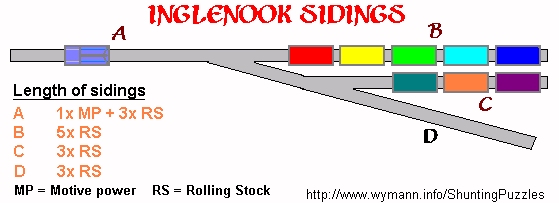 |
|
As with
most shunting puzzles, the length of the sidings
is determined by the operating rules. In the case of Inglenook Sidings,
the longest siding holds 5 wagons, while
the two others have a capacity of 3 wagons each.
The headshunt allows for
the engine plus 3 wagons (when operating, a total
of 8 wagons plus one engine will be used).
|
|
| |
 |
| |
| |
LAYOUT
SIZE
|
| |
| The resulting overall size of
the layout is small by any standards, but can vary
considerably as the actual length of the sidings is
determined by the common length of the rolling stock to
be used on the layout - the longer the rolling stock
used, the longer the sidings will need to be. |
| |
| The reduced
space requirements of Alan Wright's original
layout (1' x 4' / 30cm x 120cm) was achieved by
using standard goods wagons of the British
steam/diesel transition era which are
comparatively short, the standard wheelbase
measuring only 10'-0" (3m), giving a total
length over buffers of 20'-6" (6,15m). In 00 scale, this translates into
goods wagons about 3,2" (8cm) long, meaning
that a siding with a length of 20" (50cm)
will easily hold the 5 pieces of rolling stock
required to fit onto the longest of the three
sidings on an Inglenook layout.
|
|
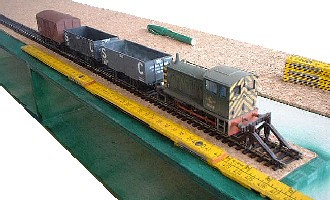
|
|
| |
| Modelling more modern freight
operations (or a completely different prototype) as a
general rule means longer rolling stock. In the UK, for
instance, the ubiquitous VDA van of the 1980s and 1990s
had the "modern standard" wheelbase of
20'-9", which scales down to a total model length
over buffers of approx. 6" / 15cm in 00. Similarly,
a 40ft North American boxcar translates into 6" (15
cm) in HO and 3" (7,5 cm) in N, whereas 50ft boxcars
scale out at 7" (17,5 cm) in HO and 3,75" (9,25
cm) in N. Tank wagons and special purpose stock will also
be of differing lengths. |
| |
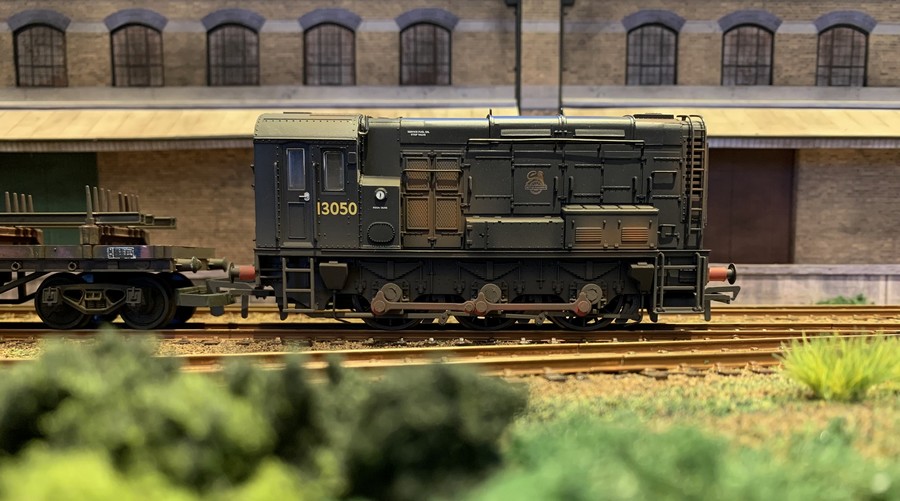
Class 08 diesel shunter on the freight-only
British prototype layout Little Bazeley
|
|
Obviously,
and this will have to be reflected in the length
of the tracks, and the longest type of
rolling stock to be used will have to serve as
the standard rolling stock length in order to
define the length of the sidings, i.e.
multiples of 5 and 3 thereof. In the case of rolling stock of
various length being used, an additional rule
needs to be introduced in order to prevent chance
constellations where it would in fact be possible
to squeeze e.g. 6 wagons onto the 5 wagon siding
The choice of locomotive
used will, of course, depend on the prototype
being modelled, but small to medium sized
shunters are a logical choice if you want to keep
the layout short in overall length.
|
|
| |
| Most British layouts fitting
the classic Inglenook dimensions seem to feature 0-6-0
tank steam engines or 0-6-0 diesel shunters, while the
General Electric 44-ton four-axles switcher is a common
favourite for US layouts. |
| |
| However,
neither the essence nor the functionality
of the Inglenook Sidings concept calls
for as small a layout as possible. If space is available,
North American prototype modellers might
prefer to opt for more common motive
power such as the GP7/9.
With longer locomotives and rolling
stock the required length of the sidings
can start to expand quite rapidly.
For example, an Inglenook layout
depicting switching moves of the mechanical reefers
used on Tropicana's "(orange) juice
train" out of Florida would require
a longer than 4' layout even in N scale
as these reefers have a real life length
of at least 57'.
|
|
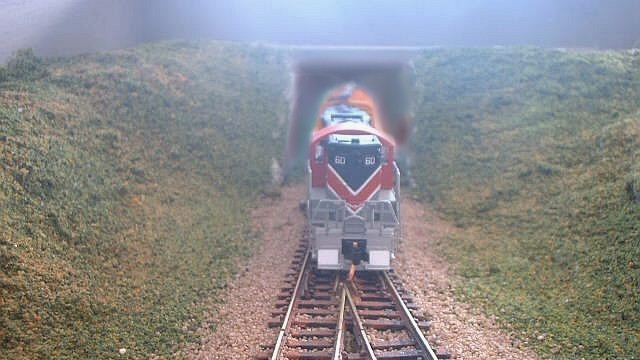
In the early morning rain, N Scale Bangor
& Aroostook GP7 #60 switches a yard
somewhere in Northern Maine
|
|
|
| |
| On the other end, 40' (modernized) boxcars can look
good on a North American switching puzzle that won't
require an excessive amount of lateral space. |
| |
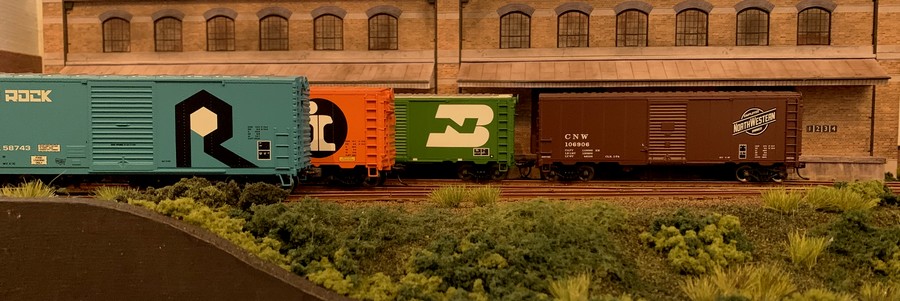 |
| |
| Another space-hungry but
potentially very interesting Inglenook variation would be
to shunt passenger coaching stock. |
| |
| |
SMALLEST
INGLENOOK POSSIBLE?
|
| |
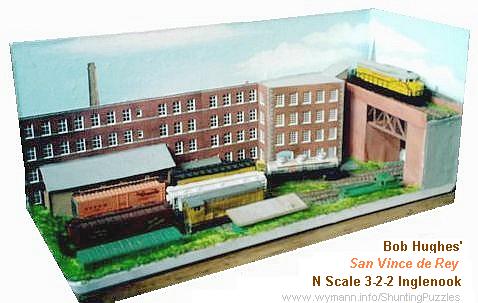
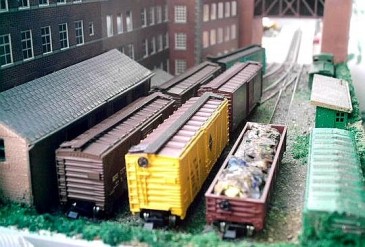
|
|
An
Inglenook Sidings layout will always be small in
comparison to other types of layouts modelled in
the same scale. But is it possible to go even
smaller than the original concept and still
maintain operating interest and have some
challenging shunting moves to do? The answer is
yes, but certain points need to be observed. Carl Arendt, the late master of
micro layout design, subjected the Inglenook
formula to some practical testing and found that
it can be cut down to one siding holding 3 cars and
two sidings holding 2 cars each, which together
with a 2 cars plus loco length headshunt will
still provide operating interest when forming a
three car train from a total of five cars
randomly placed in the sidings.
This also illustrates
just how flexible the Inglenook formula is: you
can fiddle around with the track capacities, and
you can alter the total number of freight cars on
the layout, together with the number of cars to
be assembled in order to set up the departing
train.
Bob Hughes' N Scale San
Vince de Rey (a tongue - in - cheek
reference to the fact that this layout is
actually built on a sandwich tray) works on such
a 3-2-2 "minimal" Inglenook Sidings
formula. Set in California, it portrays a small
yard in Union Pacific territory. A micro layout
by any standards, it can be kept virtually
anywhere.
Even a
"reduced" Inglenook layout offers an
operational challenge and is fun to operate, even
though the reduction in complexity of the
shunting puzzle which results from such
alterations is far more significant than most
people would suspect:
|
|
| |
| |
number
of cars |
number
of different
arrangements of cars |
number
of cars in
train to be made up |
number
of possible different
trains to be made up |
| Classic
Inglenook |
8 |
40,320 |
5 |
6,720 |
| "Minimal
Inglenook" |
5 |
120 |
3 |
60 |
|
| |
The reasons for
this drop in complexity are explained in further detail
on the shunting puzzles page, but the conclusion to be drawn from
this is, perhaps, that from an operational challenge
perspective it is better to stick with the original
formula if at all possible. Opting for shorter rolling
stock (e.g. 40' boxcars instead of 50' freight stock)
usually helps - but then again, even a "minimal
Inglenook" is better than no Inglenook...
One thing, however,
which needs to be observed very strictly, is the capacity
of the headshunt, i.e. the track leading up to the
points. This needs to hold at least the loco plus the
number of cars equivalent to the capacity of the two
shorter sidings (i.e. 3 in the classic formula, 2 in the
reduced formula). If this rule is ignored and the
capacity of the headshunt reduced, there are a number of
car arrangements which will actually prevent the loco
from pulling out the last car from the long siding,
turning it into a sitting duck.
|
| |



|
| |
Back to the Model Railways
Shunting Puzzles Website main page

|
| |
Page created:
01/MAY/2001
Last revised: 29/DEC/2021
|






